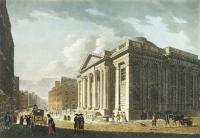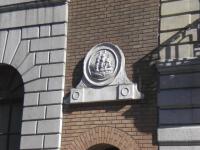‘Never let the facts interfere with a good story’: the origin of the Ouzel Galley Society
Published in 18th-19th Century Social Perspectives, 18th–19th - Century History, Features, Issue 2(March/April 2012), Volume 20
Apart from the Ouzel Galley Society, the other prominent commercial club was the Committee of Merchants, radical businessmen who organised and funded the erection of the Royal Exchange, now Dublin City Hall. (National Library of Ireland)
As the society demonstrated how fair-minded and charitable Dublin businessmen were, right back to the early eighteenth century, it was natural that the Chamber of Commerce, when founded in 1783, would want to link itself with this good-news story. And thus the story of the Ouzel’s capture and return entered the annals of Dublin history. But is it true?While there is no doubt that an arbitration body called the Ouzel Galley Society was established in the early eighteenth century, the veracity of its origin-myth is a different story. I could find no eighteenth-century record referring to the incident of the pirates. The first account of the formation of the society appeared in 1818, in Robert Walsh and James Whitelaw’s History of the city of Dublin. This said little about the ship’s disappearance and simply mentioned that an arbitration body was established in 1700 (i.e. five years before the Ouzel’s alleged return in 1705) to deal with a dispute over a Dublin ship.

If you are living in Dublin or visiting the capital you will probably have passed this fairly unremarkable and inconspicuous tablet, a representation of the Ouzel galley in Portland stone on the present-day Commercial Building near the Central Bank on Dame Street. It marks the spot where the Ouzel Galley Society had its office in the original Commercial Building, opened in 1799. The society’s own history pre-dates the building and claims 1705 as its origin.
The first reference to the involvement of pirates in the origins of the society comes from a nineteenth-century novel. William Kingston’s The missing ship must have done much to encourage the myth of the capture of a Dublin ship by pirates and its reappearance five years later. Kingston was a popular writer of fiction for boys and his themes were primarily nautical in nature. While first published in 1877 under the title The missing ship, a second edition later the same year was entitled The Ouzel Galley. The change in the title points to the popularity of the ship and the story. The novel certainly added layers to the story of the foundation of the Ouzel Galley Society. In the introduction, Kingston claimed that a descendant of the captain of the vessel in 1700 had held in his possession a logbook of the ship, detailing its adventures between 1695 and 1700. While the book was no longer extant, Kingston claimed that it was from this logbook that he took his original notes for the novel. As this is the farthest back in print the story goes, As this is the farthest back in print the story goes, it is highly likely that the premise for this novel was based on popular Dublin myth or a story of a real ship embellished over a century. HI
Lisa-Marie Griffith is Coordinator of the Heritage Project at the National Print Museum, Beggar’s Bush.
Further reading:
L.M. Cullen, Princes and pirates: the Dublin Chamber of Commerce, 1783–1983 (Dublin, 1983).L. Griffith, ‘Dublin’s commercial clubs’, in J. Kelly & M.J. Powell, Clubs and societies in eighteenth-century Ireland (Dublin, 2011).W.H. Kingston, The missing ship (London, 1877).J. Whitelaw & R. Walsh, History of the city of Dublin, from the earliest accounts to the present time (2 vols, Dublin, 1818).
















